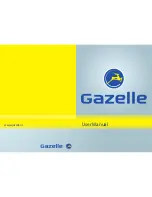
20
21
I-brake
This brake can be set to 2 modes. To 100 kg, which gives you a
braking action that is a bit less powerful. To 125 kg, with which
you achieve the maximum braking action. The I-brake requires
a break-in period to achieve the maximum braking power. If the
combined weight of the rider, luggage and bike exceeds 125
kilograms the braking action is diminished.
Brake adjustment: you can adjust the brake by turning the
adjusting bolt (A in fig. 38) upwards and then secure it with the
locknut. The brake lining is worn if the brake lever passes the
marker line “limit”. In that case you must contact your Gazelle
dealer to ensure that the brake lining will be replaced.
Hub gears
Gazelle bikes can be fitted with a Sturmey-Archer, a Sram Spectro
or a Shimano Nexus gear hub. Within these brands a further
distinction can be made between 3, 4, 5, 7 or 8-gear hubs.
Sturmey-Archer gear hubs
These types of gear hubs have 3 gears and are operated with a
twist grip. Its operation speaks for itself and therefore doesn’t
need any further clarification.
Spectro gear hubs
Spectro 3, 5 and 7-gear hubs are operated with a twist grip.
The operation is self-explanatory.
Shimano gear hubs
The Shimano 3, 4, 7 and 8-gear hubs are operated with a twist
grip. The operation is self-explanatory.
Obviously, upon delivery the gear hubs are properly adjusted.
If it is necessary to readjust them in the course of time, you can
do this yourself. The chapter “Maintenance and inspection”, on
pages 27 through 29, tells you how to adjust gear hubs. When
shifting, see to it that you lessen the pressure on the pedals or
temporarily stop pedalling.
Derailleurs
Gazelle’s more sporty models feature derailleur gears. The shifter
that operates the front derailleur is always located on the left and
the shifter of the rear derailleur is always on the right.
Modern derailleurs are always of the index type. This means that
when you press the shifter once or shift its position, the front or
rear derailleur always moves the chain up or down to an adjacent
chainwheel or sprocket.
The operation of the front derailleur
On the indicator, “3” indicates the highest gear (harder to pedal -
for speed) and “1” is the lowest (easiest to pedal - for hills) (fig. 39).
The operation of the rear derailleur
On the indicator, the highest number indicates the highest gear
(harder to pedal - for speed) and the lowest number the lowest
gear (easiest to pedal - for hills) (fig. 40).
In the case of combined brake/gear levers found on cycles with
racing style ‘drop’ handlebars the brake lever should be pulled in
once for shifting up one sprocket (D). To shift back the inner lever
(B) is pulled in (figs. 41 and 42).
If the derailleur does not change gears properly, it can be
adjusted. In the chapter “Maintenance and inspection”, on page
30, you can read everything about the adjustment.
On a bike with derailleur gears you must keep on pedalling while
shifting. However, it is advisable to limit the pedalling power
during shifting to minimize wear on transmission components.
The use of the bike
38
39
40
41
42
A
B
D
B
D
8
1
3
1
Содержание bike
Страница 1: ...User Manual www gazelle nl...
Страница 26: ...50 51 Notes...












































